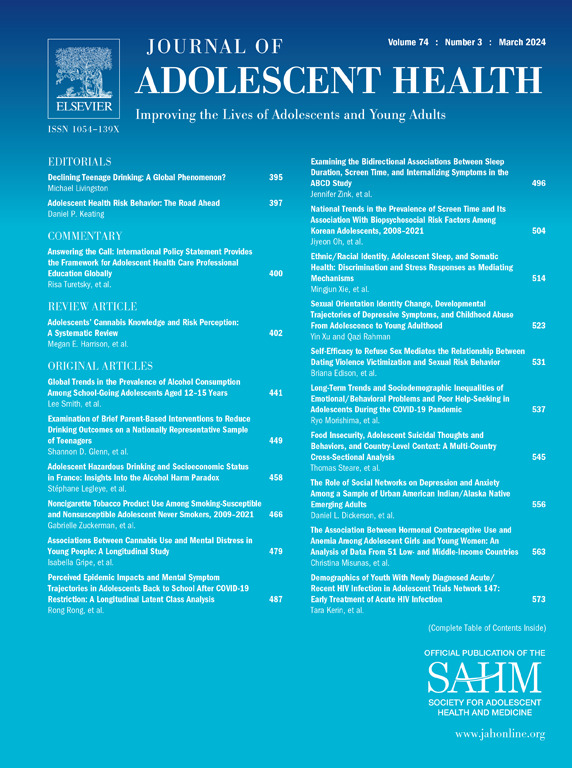Effectiveness of Educational Interventions on Adolescent Knowledge and Practices for Preventing Noncommunicable Diseases in Low- and Middle-Income Countries: A Systematic Review and Meta-Analysis
IF 5.5
2区 医学
Q1 PEDIATRICS
引用次数: 0
Abstract
Noncommunicable diseases (NCDs) such as cardiovascular diseases, diabetes, and cancers are major global health concerns, disproportionately impacting low- and middle-income countries (LMICs). Adolescents in LMICs are particularly vulnerable due to urbanization, lifestyle changes, and limited preventive care access. This study evaluates the effectiveness of educational interventions in improving adolescents' knowledge, and behaviors, for NCD prevention in LMICs. The systematic review and meta-analysis followed patient, intervention, comparison, outcome and preferred reporting items for systematic reviews and meta-analyses guidelines, targeting studies involving adolescents aged 10–19 who received educational interventions for NCD prevention. A comprehensive search across 5 databases identified 22 eligible studies. Study quality was assessed using the Cochrane risk-of-bias tool, and statistical analyses were conducted in R, with effect sizes expressed as risk ratios and mean differences, calculated with 95% confidence intervals (CIs). Educational interventions significantly improved knowledge about the health benefits of fruit consumption (mean difference: 0.52; 95% CI: 0.31–0.74; p < .001) and awareness of the harms of deep-fried foods (mean difference: 0.60; 95% CI: 0.43–0.76; p < .001). Interventions also reduced screen time (mean difference: 534.09 minutes; 95% CI: 345.39–722.80). However, changes in body mass index (mean difference: 0.04; 95% CI: −0.02 to 0.11; p = .193) and waist circumference (mean difference: 0.06; 95% CI: −0.33 to 0.45; p = .778) were not statistically significant. Multisession interventions involving parents and teachers showed greater improvements in physical fitness, dietary habits, and quality of life. Single-session interventions were effective mainly when involving parents. Educational interventions improve knowledge and reduce screen time among adolescents, laying a foundation for healthier behaviors. However, achieving sustained behavior change requires targeted strategies beyond education alone. Future programs should incorporate skill-building, follow-up, family or community involvement to support adolescents in adopting and maintaining healthy habits. Comprehensive, multicomponent interventions are essential for fostering long-term lifestyle changes and reducing NCD risk among adolescents in LMICs.
教育干预对低收入和中等收入国家青少年预防非传染性疾病的知识和实践的有效性:系统回顾和荟萃分析。
心血管疾病、糖尿病和癌症等非传染性疾病是主要的全球卫生问题,对低收入和中等收入国家的影响尤为严重。由于城市化、生活方式的改变和有限的预防保健机会,低收入和中等收入国家的青少年尤其容易受到伤害。本研究评估了教育干预在提高中低收入国家青少年非传染性疾病预防知识和行为方面的有效性。系统评价和荟萃分析跟踪了患者、干预、比较、结果和系统评价和荟萃分析指南的首选报告项目,目标研究涉及10-19岁接受非传染性疾病预防教育干预的青少年。在5个数据库中进行了全面搜索,确定了22项符合条件的研究。使用Cochrane风险偏倚工具评估研究质量,并以R进行统计分析,效应量表示为风险比和平均差异,以95%置信区间(ci)计算。教育干预显著提高了对水果消费健康益处的认识(平均差异:0.52;95% ci: 0.31-0.74;P < 0.001)和对油炸食品危害的认识(平均差异:0.60;95% ci: 0.43-0.76;P < 0.001)。干预措施也减少了屏幕时间(平均差异:534.09分钟;95% ci: 345.39-722.80)。然而,体重指数的变化(平均差值:0.04;95% CI: -0.02 ~ 0.11;P = .193)和腰围(平均差值:0.06;95% CI: -0.33 ~ 0.45;P = .778)无统计学意义。有家长和老师参与的多时段干预显示,在身体健康、饮食习惯和生活质量方面有了更大的改善。单次干预主要在父母参与的情况下有效。教育干预措施提高了青少年的知识,减少了他们使用屏幕的时间,为养成更健康的行为奠定了基础。然而,实现持续的行为改变需要有针对性的策略,而不仅仅是教育。今后的方案应包括技能培养、后续行动、家庭或社区参与,以支持青少年养成和保持健康的习惯。全面、多成分的干预措施对于促进低收入中低收入国家青少年长期改变生活方式和降低非传染性疾病风险至关重要。
本文章由计算机程序翻译,如有差异,请以英文原文为准。
求助全文
约1分钟内获得全文
求助全文
来源期刊

Journal of Adolescent Health
医学-公共卫生、环境卫生与职业卫生
CiteScore
10.40
自引率
3.90%
发文量
526
审稿时长
46 days
期刊介绍:
The Journal of Adolescent Health is a scientific publication dedicated to enhancing the health and well-being of adolescents and young adults. Our Journal covers a broad range of research topics, spanning from the basic biological and behavioral sciences to public health and policy. We welcome a variety of contributions, including original research papers, concise reports, literature reviews, clinical case reports, opinion pieces, and letters to the editor. We encourage professionals from diverse disciplines such as Anthropology, Education, Ethics, Global Health, Health Services Research, Law, Medicine, Mental and Behavioral Health, Nursing, Nutrition, Psychology, Public Health and Policy, Social Work, Sociology, and Youth Development to share their expertise and contribute to our mission of promoting adolescent health. Moreover, we value the voices of young individuals, family and community members, and healthcare professionals, and encourage them to submit poetry, personal narratives, images, and other creative works that provide unique insights into the experiences of adolescents and young adults. By combining scientific peer-reviewed research with creative expressions, our Journal aims to create a comprehensive understanding of the challenges and opportunities in adolescent and young adult health.
 求助内容:
求助内容: 应助结果提醒方式:
应助结果提醒方式:


